Vahid Aref
Equalization-Enhanced Phase Noise: Modeling and DSP-aware Analysis
Mar 17, 2025Abstract:In coherent optical communication systems the laser phase noise is commonly modeled as a Wiener process. We propose a sliding-window based linearization of the phase noise, enabling a novel description. We show that, by stochastically modeling the residual error introduced by this approximation, equalization-enhanced phase noise (EEPN) can be described and decomposed into four different components. Furthermore, we analyze the four components separately and provide a stochastical model for each of them. This novel model allows to predict the impact of well-known algorithms in coherent digital signal processing (DSP) pipelines such as timing recovery (TR) and carrier phase recovery (CPR) on each of the terms. Thus, it enables to approximate the resulting signal affected by EEPN after each of these DSP steps and helps to derive appropriate ways of mitigating such effects.
A Novel Phenomenological Model of Equalization-enhanced Phase Noise
Feb 10, 2025


Abstract:We show that equalization-enhanced phase noise manifests as a time-varying, frequency-dependent phase error, which can be modeled and reversed by a time-varying all-pass finite impulse response filter.
Low-complexity Samples versus Symbols-based Neural Network Receiver for Channel Equalization
Aug 28, 2023Abstract:Low-complexity neural networks (NNs) have successfully been applied for digital signal processing (DSP) in short-reach intensity-modulated directly detected optical links, where chromatic dispersion-induced impairments significantly limit the transmission distance. The NN-based equalizers are usually optimized independently from other DSP components, such as matched filtering. This approach may result in lower equalization performance. Alternatively, optimizing a NN equalizer to perform functionalities of multiple DSP blocks may increase transmission reach while keeping the complexity low. In this work, we propose a low-complexity NN that performs samples-to-symbol equalization, meaning that the NN-based equalizer includes match filtering and downsampling. We compare it to a samples-to-sample equalization approach followed by match filtering and downsampling in terms of performance and computational complexity. Both approaches are evaluated using three different types of NNs combined with optical preprocessing. We numerically and experimentally show that the proposed samples-to-symbol equalization approach applied for 32 GBd on-off keying (OOK) signals outperforms the samples-domain alternative keeping the computational complexity low. Additionally, the different types of NN-based equalizers are compared in terms of performance with respect to computational complexity.
Model-Based Deep Learning of Joint Probabilistic and Geometric Shaping for Optical Communication
Apr 05, 2022

Abstract:Autoencoder-based deep learning is applied to jointly optimize geometric and probabilistic constellation shaping for optical coherent communication. The optimized constellation shaping outperforms the 256 QAM Maxwell-Boltzmann probabilistic distribution with extra 0.05 bits/4D-symbol mutual information for 64 GBd transmission over 170 km SMF link.
Efficient Training of Volterra Series-Based Pre-distortion Filter Using Neural Networks
Dec 13, 2021

Abstract:We present a simple, efficient "direct learning" approach to train Volterra series-based digital pre-distortion filters using neural networks. We show its superior performance over conventional training methods using a 64-QAM 64-GBaud simulated transmitter with varying transmitter nonlinearity and noisy conditions.
End-to-End Learning of Joint Geometric and Probabilistic Constellation Shaping
Dec 09, 2021
Abstract:We present a novel autoencoder-based learning of joint geometric and probabilistic constellation shaping for coded-modulation systems. It can maximize either the mutual information (for symbol-metric decoding) or the generalized mutual information (for bit-metric decoding).
Neural networks based post-equalization in coherent optical systems: regression versus classification
Oct 17, 2021
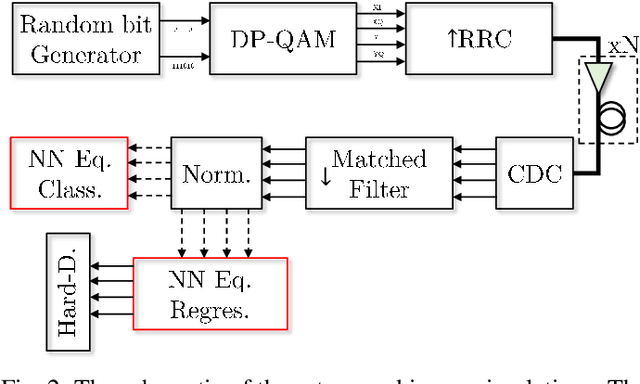
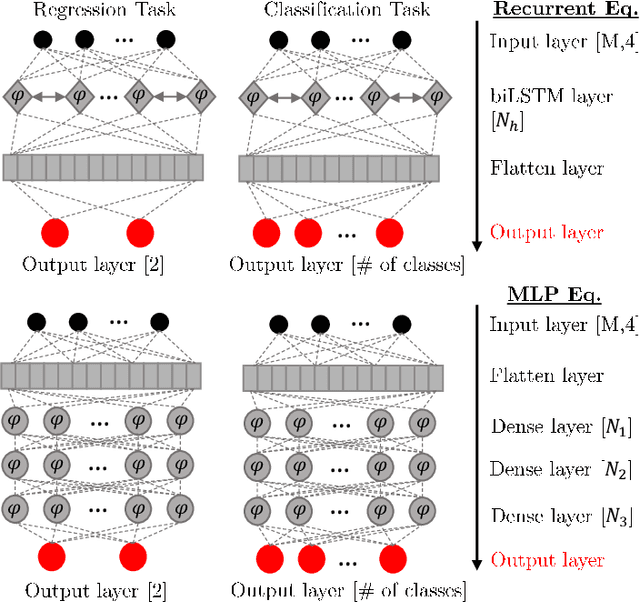

Abstract:In this paper, we address the question of which type of predictive modeling, classification, or regression, fits better the task of equalization using neural networks (NN) based post-processing in coherent optical communication, where the transmission channel is nonlinear and dispersive. For the first time, we presented some possible drawbacks in using each type of predictive task in a machine learning context for the nonlinear channel equalization problem. We studied two types of equalizers based on the feed-forward and recurrent neural networks over several different transmission scenarios, in linear and nonlinear regimes of the optical channel. We observed in all those cases that the training based on regression results in faster convergence and finally a superior performance, in terms of Q-factor and achievable information rate.
On the Comparison of Single-Carrier vs. Digital Multi-Carrier Signaling for Long-Haul Transmission of Probabilistically Shaped Constellation Formats
Sep 22, 2021


Abstract:We report on theoretical and experimental investigations of the nonlinear tolerance of single carrier and digital multicarrier approaches with probabilistically shaped constellations. Experimental transmission of PCS16QAM is assessed at 120 GBd over an ultra-long-haul distance.
Single-ended Coherent Receiver
Sep 12, 2021
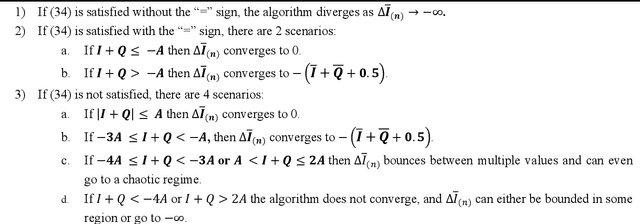


Abstract:Commercial coherent receivers utilize balanced photodetectors (PDs) with high single-port rejection ratio (SPRR) to mitigate the signal-signal beat interference (SSBI) due to the square-law detection process. As the symbol rates of coherent transponders are increased to 100 Gbaud and beyond, maintaining a high SPRR in a cost-effective manner becomes more and more challenging. One potential approach for solving this problem is to leverage the concept of single-ended coherent receiver (SER) where single-ended PDs are used instead of the balanced PDs. In this case, the resulting SSBI should be mitigated in the digital domain. In this paper, we show that SSBI can be effectively mitigated using various low-complexity techniques, such as the direct filed reconstruction (DFR), clipped iterative SSBI cancellation (CIC) and gradient decent (GD). In addition, we present a self-calibration technique for SERs which can be extended for characterizing the optical-to-electrical (O/E) response of a conventional balanced coherent receiver (BR). Using the developed techniques, we then experimentally demonstrate a 90 Gbaud probabilistically constellation shaped 64-QAM (PCS-64QAM) transmission using a SER, achieving a net data rate of 882 Gb/s over 100 km of standard single mode fiber (SSMF). The sensitivity penalty compared to the BR is below 0.5 dB. We expect that when the symbol rate is increased further, a SER can potentially outperform a BR, especially when applied to cost-sensitive commercial pluggable coherent transceivers
End-to-End Deep Learning of Long-Haul Coherent Optical Fiber Communications via Regular Perturbation Model
Jul 26, 2021
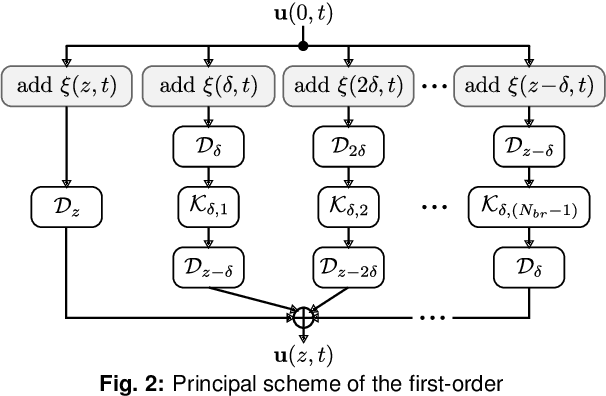
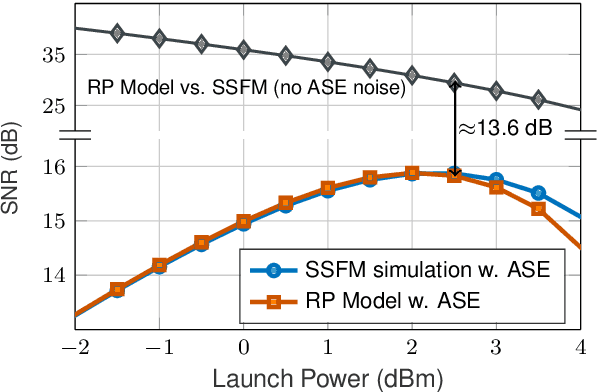
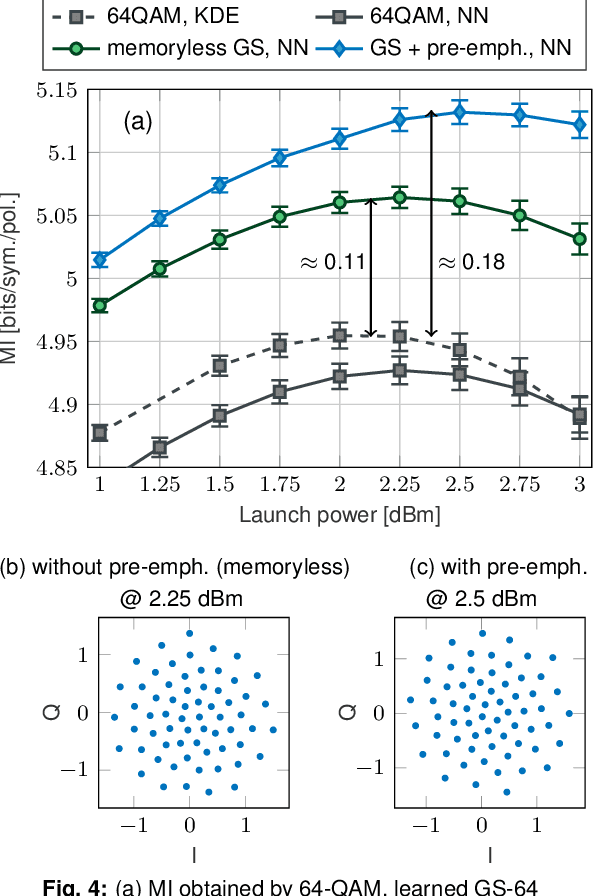
Abstract:We present a novel end-to-end autoencoder-based learning for coherent optical communications using a "parallelizable" perturbative channel model. We jointly optimized constellation shaping and nonlinear pre-emphasis achieving mutual information gain of 0.18 bits/sym./pol. simulating 64 GBd dual-polarization single-channel transmission over 30x80 km G.652 SMF link with EDFAs.
 Add to Chrome
Add to Chrome Add to Firefox
Add to Firefox Add to Edge
Add to Edge